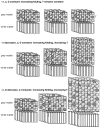How the cortex gets its folds: an inside-out, connectivity-driven model for the scaling of Mammalian cortical folding
- PMID: 22347170
- PMCID: PMC3270328
- DOI: 10.3389/fnana.2012.00003
How the cortex gets its folds: an inside-out, connectivity-driven model for the scaling of Mammalian cortical folding
Abstract
Larger mammalian cerebral cortices tend to have increasingly folded surfaces, often considered to result from the lateral expansion of the gray matter (GM), which, in a volume constrained by the cranium, causes mechanical compression that is relieved by inward folding of the white matter (WM), or to result from differential expansion of cortical layers. Across species, thinner cortices, presumably more pliable, would offer less resistance and hence become more folded than thicker cortices of a same size. However, such models do not acknowledge evidence in favor of a tension-based pull onto the GM from the inside, holding it in place even when the constraint imposed by the cranium is removed. Here we propose a testable, quantitative model of cortical folding driven by tension along the length of axons in the WM that assumes that connections through the WM are formed early in development, at the same time as the GM becomes folded, and considers that axonal connections through the WM generate tension that leads to inward folding of the WM surface, which pulls the GM surface inward. As an important necessary simplifying hypothesis, we assume that axons leaving or entering the WM do so approximately perpendicularly to the WM-GM interface. Cortical folding is thus driven by WM connectivity, and is a function of the fraction of cortical neurons connected through the WM, the average length, and the average cross-sectional area of the axons in the WM. Our model predicts that the different scaling of cortical folding across mammalian orders corresponds to different combinations of scaling of connectivity, axonal cross-sectional area, and tension along WM axons, instead of being a simple function of the number of GM neurons. Our model also explains variations in average cortical thickness as a result of the factors that lead to cortical folding, rather than as a determinant of folding; predicts that for a same tension, folding increases with connectivity through the WM and increased axonal cross-section; and that, for a same number of neurons, higher connectivity through the WM leads to a higher degree of folding as well as an on average thinner GM across species.
Keywords: allometry; axon caliber; brain size; connectivity; cortical folding; cortical thickness; evolution; white matter.
Figures



Similar articles
-
The human cerebral cortex is neither one nor many: neuronal distribution reveals two quantitatively different zones in the gray matter, three in the white matter, and explains local variations in cortical folding.Front Neuroanat. 2013 Sep 2;7:28. doi: 10.3389/fnana.2013.00028. eCollection 2013. Front Neuroanat. 2013. PMID: 24032005 Free PMC article.
-
Connectivity-driven white matter scaling and folding in primate cerebral cortex.Proc Natl Acad Sci U S A. 2010 Nov 2;107(44):19008-13. doi: 10.1073/pnas.1012590107. Epub 2010 Oct 18. Proc Natl Acad Sci U S A. 2010. PMID: 20956290 Free PMC article.
-
Different scaling of white matter volume, cortical connectivity, and gyrification across rodent and primate brains.Front Neuroanat. 2013 Apr 9;7:3. doi: 10.3389/fnana.2013.00003. eCollection 2013. Front Neuroanat. 2013. PMID: 23576961 Free PMC article.
-
Scaling of cortical neuron density and white matter volume in mammals.J Hirnforsch. 1997;38(4):513-24. J Hirnforsch. 1997. PMID: 9476216 Review.
-
Development of cortical folding during evolution and ontogeny.Trends Neurosci. 2013 May;36(5):275-84. doi: 10.1016/j.tins.2013.01.006. Epub 2013 Feb 14. Trends Neurosci. 2013. PMID: 23415112 Review.
Cited by
-
Aberrant allometric scaling of cortical folding in preterm-born adults.Brain Commun. 2022 Dec 26;5(1):fcac341. doi: 10.1093/braincomms/fcac341. eCollection 2023. Brain Commun. 2022. PMID: 36632185 Free PMC article.
-
The human cerebral cortex is neither one nor many: neuronal distribution reveals two quantitatively different zones in the gray matter, three in the white matter, and explains local variations in cortical folding.Front Neuroanat. 2013 Sep 2;7:28. doi: 10.3389/fnana.2013.00028. eCollection 2013. Front Neuroanat. 2013. PMID: 24032005 Free PMC article.
-
A model of tension-induced fiber growth predicts white matter organization during brain folding.Nat Commun. 2021 Nov 18;12(1):6681. doi: 10.1038/s41467-021-26971-9. Nat Commun. 2021. PMID: 34795256 Free PMC article.
-
Brain scaling in mammalian evolution as a consequence of concerted and mosaic changes in numbers of neurons and average neuronal cell size.Front Neuroanat. 2014 Aug 11;8:77. doi: 10.3389/fnana.2014.00077. eCollection 2014. Front Neuroanat. 2014. PMID: 25157220 Free PMC article. Review.
-
Paracingulate sulcus morphology is associated with hallucinations in the human brain.Nat Commun. 2015 Nov 17;6:8956. doi: 10.1038/ncomms9956. Nat Commun. 2015. PMID: 26573408 Free PMC article.
References
-
- Braitenberg V., Schüz A. (1998). Cortex: Statistics and Geometry of Neuronal Connectivity, 2nd Edn. Berlin: Springer Verlag
LinkOut - more resources
Full Text Sources
Research Materials

